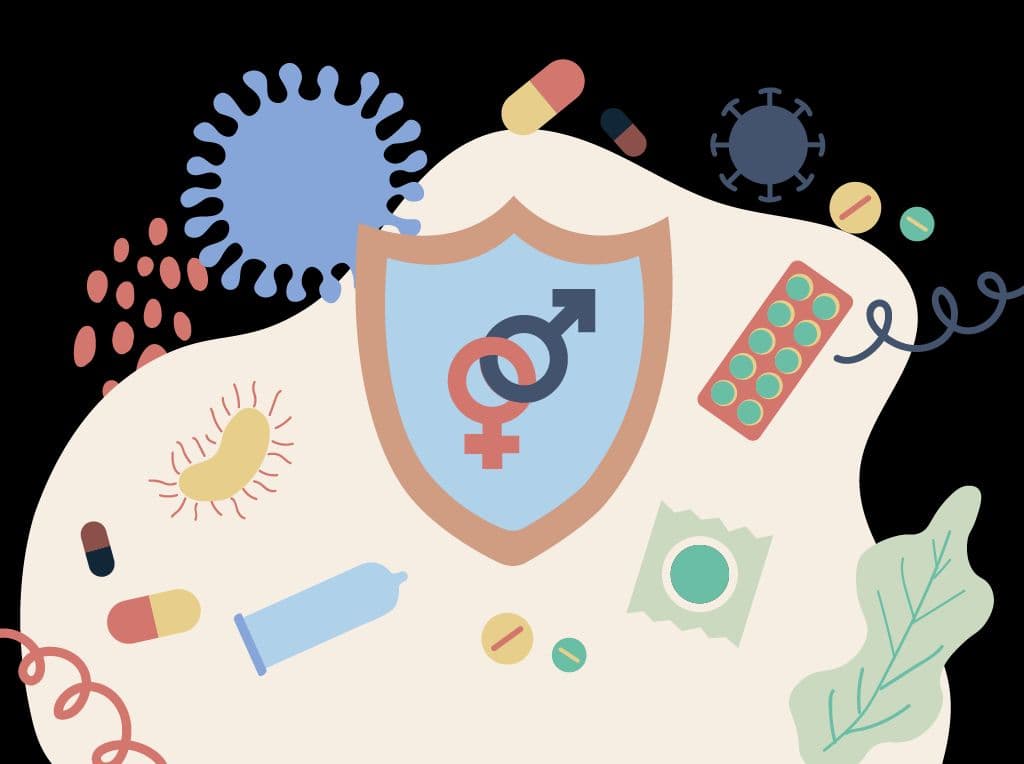Urinary tract infections (UTIs) are widespread - more than half of the assigned female at birth population worldwide would suffer from it at some point in their lifetime. While people of any gender can get a UTI, vagina owners are up to 30 times more susceptible to infections. While UTIs can be painful and annoying, more often than not, they can be easily treated with antibiotics.
What is a UTI?
A urinary tract infection (UTI) is an infection in any part of your urinary system — your kidneys, ureters, bladder, and urethra. UTI can involve your urethra (a condition called urethritis), or bladder (a condition called cystitis), or kidneys (a condition called pyelonephritis). Most infections involve the lower urinary tract, which is the bladder and the urethra.
When do UTIs become recurrent?
If a person has two or more episodes of UTI in 6 months or more than four episodes in a year, it is labelled as a Recurrent UTI. Some Physicians consider a threshold of 3 UTIs in 12 months to signify recurrent UTIs.
Why are women more prone to UTIs than men?
Vaginal owners are at greater risk of developing UTIs because of their anatomy — specifically, the short distance from the urethral opening to the anus and the urethral opening to the bladder. Other factors could include hormonal changes and the different stages of the reproductive life cycle. Let’s take a look -
1. Length of the urethra
The urethra is the tube that carries urine from the bladder out of the body. While it acts as an exit for urine, it may also act as an entrance for bacteria. The average female urethra is about an inch or two long compared to the male urethra, which is 6 inches long. Hence, the bacteria planted at the opening of the urethra have a shorter distance to travel to infect the bladder in females than in males.
2. More sensitive skin
The external urethral meatus is mostly mucosa - the moist tissue that lines the inside of the vagina. As a result, the female urethra is easier to traumatise and irritate, and the irritated skin permits the bacteria to potentially live and grow.
3. Sexual contact
Sexual contact can allow bacteria near the vagina to get into the urethra.
4. Specific contraception methods
Spermicide may cause vaginal irritation, allowing the bacteria to grow. Diaphragms are used with spermicide and can contribute to UTIs because they push against the urethra and do not allow complete bladder cleansing. The urine that remains is more likely to grow bacteria that can cause infection.
5. Menopause
With menopause, falling estrogen levels cause changes in the genito-urinary tract making it more vulnerable to infections.
6. Pregnancy
Pregnant women are also more prone to getting UTIs. Severe UTI in pregnancy may cause problems for you and your baby.

What are the common symptoms of UTIs?
Some symptoms of UTIs can include:
- A strong, persistent urge to urinate
- A burning sensation when urinating
- Passing frequent, small amounts of urine
- Urine that appears cloudy
- Urine that appears red, bright pink, or cola-coloured — a sign of blood in the urine
- Strong-smelling urine
- Pelvic pain, in women — especially in the centre of the pelvis and around the area of the pubic bone
Other symptoms that may be associated with a urinary tract infection include:
- Pain during sex.
- Penis pain.
- Flank (side of the body) pain or lower back pain.
- Fatigue.
- Fever (temperature above 100 degrees Fahrenheit) and chills.
- Vomiting.
- Mental changes or confusion.
What are the causes of UTIs?
As UTIs are prevalent, vaginal owners are often advised to wipe from front to back after using the bathroom. Since the urethra is close to the anus, bacteria from the large intestine, such as E. coli, can sometimes travel from the anus to your urethra and further to the bladder. If the infection isn't treated, it can continue to infect your kidneys. Having sex can introduce bacteria into your urinary tract, too.
Some folks are more likely to get UTIs genetically. Vaginal owners with diabetes may be at higher risk because their immune systems are weak and cannot fight off infections. Other conditions include hormone changes, multiple sclerosis, kidney infection and stones, a stroke, or a spinal cord injury.
What tests can be used to diagnose UTIs?
If you suspect that you have a urinary tract infection, go to the doctor. Your doctor will use the following tests to diagnose a urinary tract infection:
- Urinalysis: To examine the urine for red blood cells, white blood cells, and bacteria to indicate an infection.
- Urine culture: To determine the type of bacteria in your urine.
If your infection does not respond to treatment or in case of recurring infection, your doctor may use the following tests to examine your urinary tract for disease or injury:
- Ultrasound: Sound waves create an image of the internal organs.
- Cystoscopy: Uses a special instrument fitted with a lens and a light source (cystoscope) to see inside the bladder from the urethra.
- CT scan: A type of X-ray that takes cross-sections of the body (like slices).
How can UTIs be treated?
Antibiotics are the most common UTI treatment. You must follow your healthcare provider’s directions for taking medicine. Also, take medication only when prescribed. Do not stop taking them just because you feel your symptoms are improving. If the infection is not treated completely with the full course of antibiotics, it can return.
Drinking plenty of water to flush out the bacteria is advised.
A UTI can cause pain in the pelvic area. Applying a heating pad to the lower abdomen can help relieve pain and discomfort temporarily.
Complications of untreated UTIs?
If treated well and rightly, a UTI is not likely to damage your urinary tract. If left untreated, the infection can spread to the kidneys and other parts of your body. The most common symptoms of kidney infection are fever and pain in the back where the kidneys are located. Sometimes the infection can get into the bloodstream. This is rare but can adversely affect your overall health immensely.
Prevention of UTI
1. Drink fluids
Experts recommend drinking six to eight 8-ounce glasses of water in a day, but people can check with their doctor how much water they need, as too much may not be beneficial. Frequent consumption of fresh juices, especially berry juices, and fermented milk products containing probiotic bacteria was associated with a decreased risk of recurrence of UTIs. Cranberry juice may help treat UTIs. The red berry contains a tannin that might prevent E. coli bacteria, which is the most common cause of urinary tract infections.
2. Take proper diet
Dietary factors may help manage and prevent UTIs. Foods that may irritate the bladder include coffee, alcohol, citrus fruits, tomato-based foods, artificial sweeteners, and spicy foods. Whole foods including pears, bananas, green beans, potatoes, lean proteins, bread, nuts, and eggs are good to manage UTIs. According to a 2020 study, following a plant-based diet may lower the risk of developing a UTI due to the antibacterial effect of antioxidants.
While processed foods provide fewer antioxidants and other nutrients while also increasing the levels of free radicals, which can lead to inflammation and cell damage.
D-mannose is a sugar that naturally features fruits and vegetables, such as apples, cranberries, and seaweed. It may stop bacteria from sticking to cells in the urinary tract, according to researchers.
3. Do not hold your pee
One of the symptoms of a UTI is pain when urinating. Health experts advise people to urinate as and when they need to or every 2–3 hours. Holding urine in may cause the bacteria to multiply. Drinking plenty of fluids may help ease the discomfort of urination.
Other ways to prevent UTIs include:
- try the blotting technique, instead of wiping after urination
- avoid using soap, vaginal douches, and other feminine hygiene products in the genital area
- consider changing birth control methods, because diaphragms and spermicide-treated condoms can cause bacterial growth
- take a shower instead of a bath
- urinate before and after sexual intercourse
- wipe and wash well after intercourse
Experts are also looking at new ways to treat and prevent UTIs, including vaccines and things that boost your immune system.
When to see a doctor?
Many UTIs produce mild symptoms and resolve in 2–3 days with home treatment.
However, a person should see their doctor if:
- symptoms worsen
- In case of recurring infection
- the person has a weakened immune system
Final Words
Your healthcare provider can treat most urinary tract infections. If you have frequent recurrences or a chronic kidney infection, you may be referred to a urologist or nephrologist for an evaluation. Urinary tract infections (UTIs) typically respond very well to treatment. Once your healthcare provider identifies the type of bacteria and prescribes the right antibiotic medication, your symptoms should improve quickly. If you have frequent UTIs or if your symptoms aren’t improving, your provider may test to see if it’s an antibiotic-resistant infection. Finally, keep yourself hydrated, and drink plenty of fluids to cleanse your Urinary tract.
Read More: UTI Be Gone! All You Need to Know to Keep UTIs Away for Good
Disclaimer - This information is educational and should not be construed as medical advice. Please consult your doctor before making any dietary changes or adding supplements.
Proactive For Her is a digital clinic for women, offering accessible, personalised, and confidential healthcare solutions. We offer out-patient care, diagnostic services and programs for various health concerns of Indian women, across their lifetime - from puberty to pregnancy to menopause.

